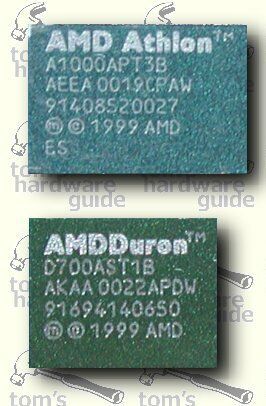The Celeron Killer: AMD's New Duron Processor
Duron Is Not Castrated, Celeron Is
Most of you will certainly know that Intel's latest Celeron processors at 566 MHz and up are using the so-called 'Coppermine-128' core. This core is identical to the silicon used for Pentium III (E) processors, with half of its L2-cache disabled, resulting in only 128 kB second level cache versus the 256 kB L2-cache of Pentium III. On top of that, Intel is hindering the performance of Celeron by specifying it for a today mediocre 66 MHz bus clock. Only Celeron-overclockers know the real potential of the Celeron, the 'normal' Celeron user finds himself with a chip that is seriously limited by this slow bus clock.
The story is a lot different with AMD's Duron-processor. First of all, Duron is using it's own silicon-design. Duron has only got a quarter of Thunderbird's L2-cache, it's not a Thunderbird-core with 192 kB L2-cache disabled. AMD is taking advantage of the fact that Duron has its own special die, so that saving the actual 192 kB L2-cache leads to a smaller die size of Duron, if you compare it to Thunderbird.

While Thunderbird's die size is 120 mm², Duron's die is only 100 mm² big. Thus AMD can produce Duron cheaper than Thunderbird, while Intel's costs for producing Celeron are the same as for the production of Pentium III processors.
I already pointed out that Celeron is castrated by the fact that it's only supposed to run at 66 MHz bus clock, which has a significant performance impact. AMD is not trying to slow down Duron artificially. Instead of that AMD is using the honest approach and runs Duron at the same bus clock of 200 MHz DDR that is also used by any Athlon-processor. This fact is the secret of Duron's superior performance over Intel's Celeron, as you will see later.
Stay on the Cutting Edge
Join the experts who read Tom's Hardware for the inside track on enthusiast PC tech news — and have for over 25 years. We'll send breaking news and in-depth reviews of CPUs, GPUs, AI, maker hardware and more straight to your inbox.
Current page: Duron Is Not Castrated, Celeron Is
Prev Page Athlon's Little Brother Next Page Comparison Between Duron And CeleronMost Popular

